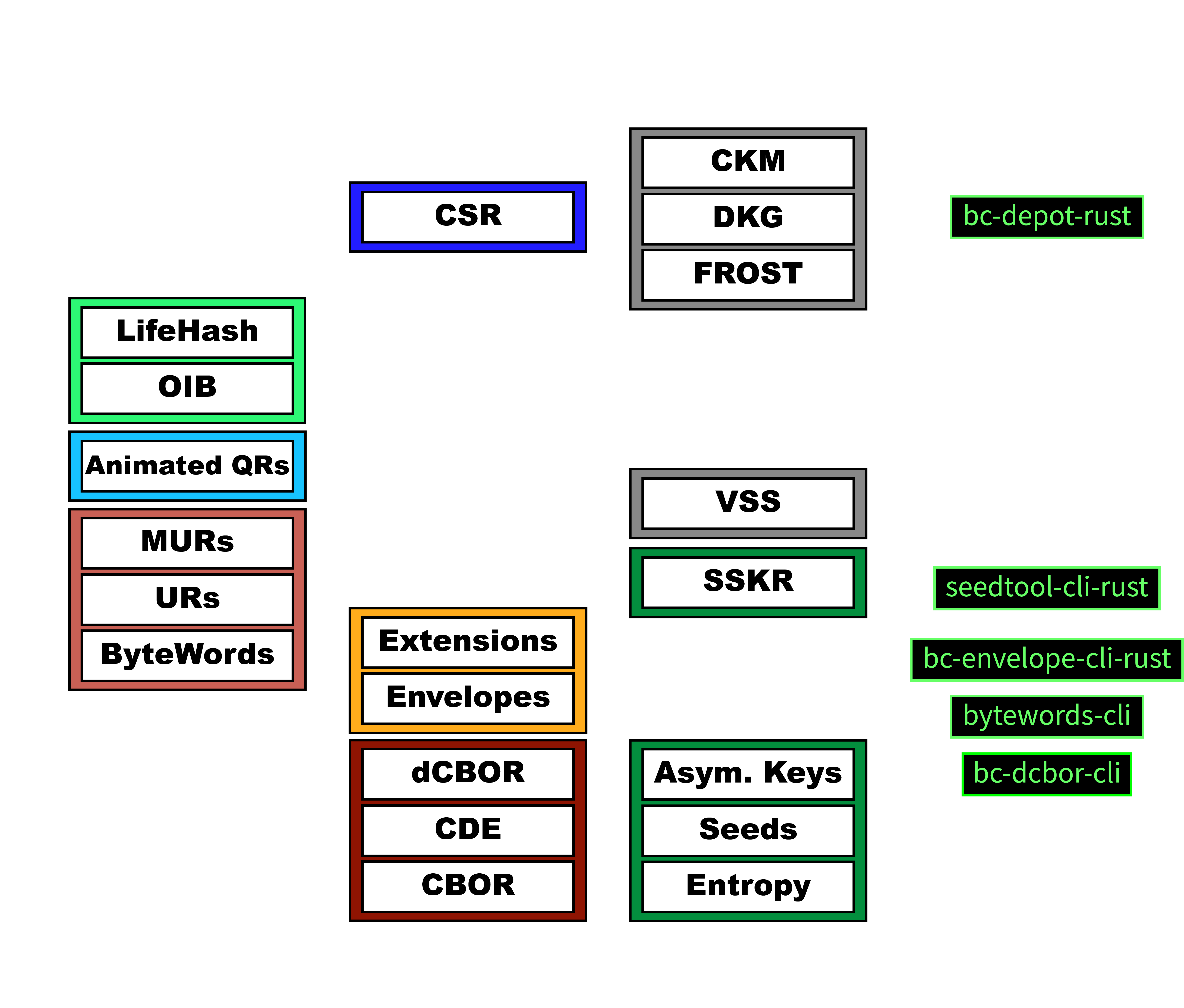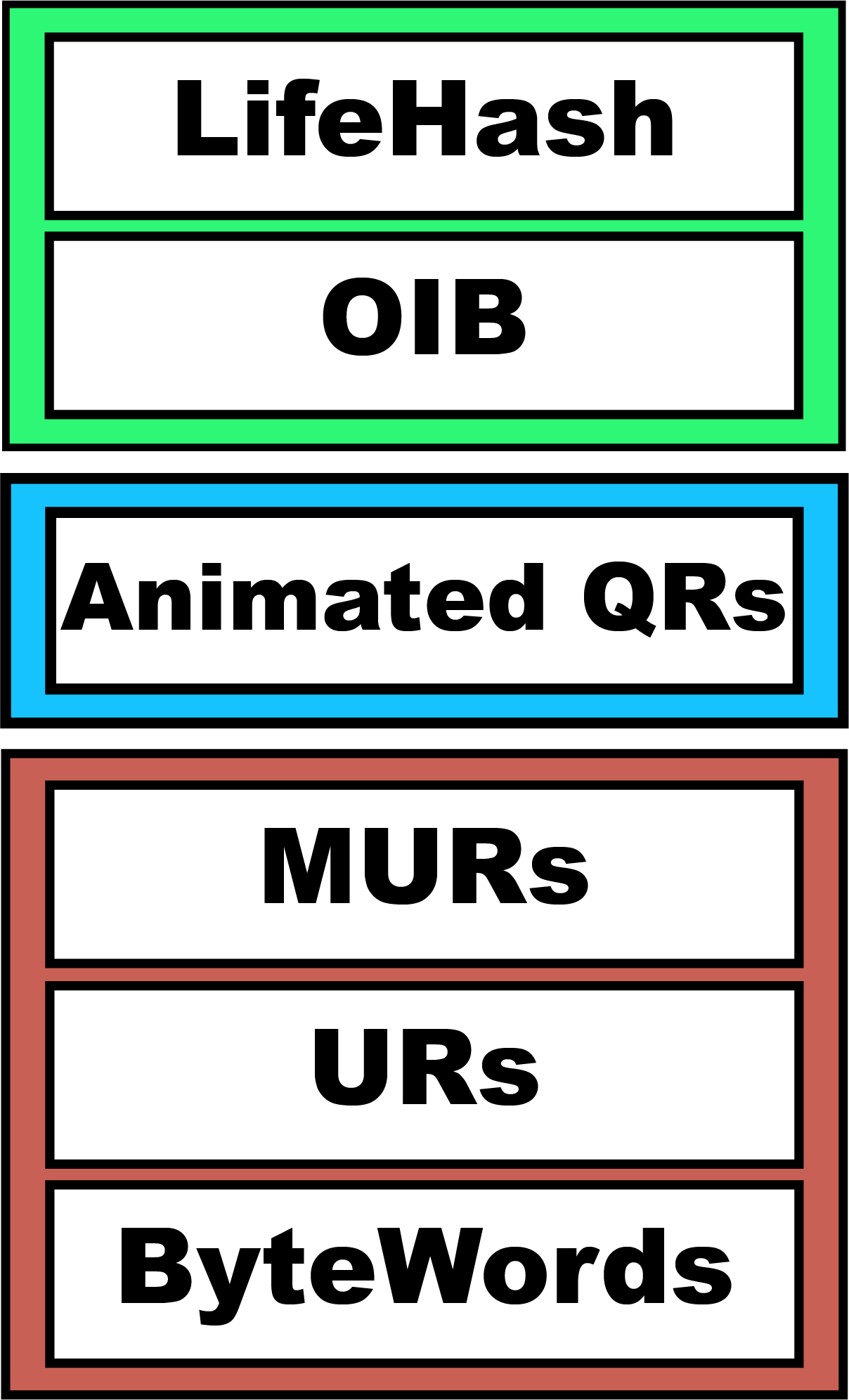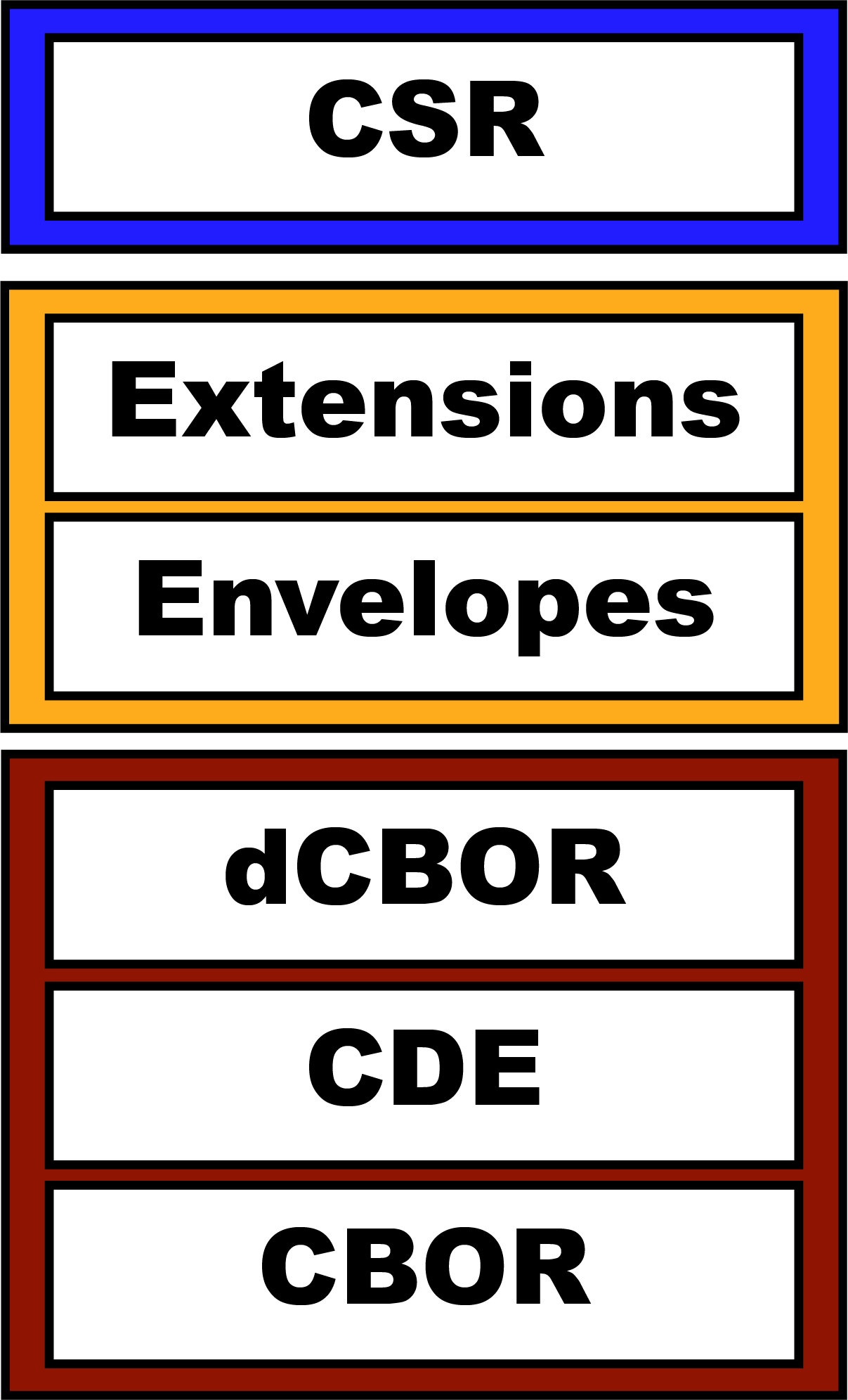Latest News: Published Learning FROST from the Command Line, a major new course (11/6/25). Added several pages on Gordian Clubs, building on demo from October’s Gordian Developers meeting (10/2/25). Added page on provenance marks (8/28/25).
The Gordian Stack is a layered set of specifications founded on the CBOR data format and built up from that, step by step, to support digital-asset management in a way that fulfills the Gordian Principles. These developer pages contain developer resources that explain the elements in the Stack, and their importance, and make it easy for you to adopt them. For more support, you can also attend our Gordian Meetings, usually on the first Wednesday of the month.

The heart of the Gordian Stack is the Gordian Envelope, a simple data-storage mechanism that organizes content into semantic triples. You don’t need to know about the underlying elements to use Envelopes, so as a developer you can jump straight in and be confident that everything under Envelope is correctly abstracted to maintain layer divisions.
The Animated QR specification, built on Multipart Uniform Resources (MURs), is the other major entry point to the Gordian Stack, since it allows for the transmission of large data sets, such as Bitcoin’s PSBTs, across Airgaps.
Following is a description of the major layers of the Gordian Stack, in descending order.
If you have any questions or want more resources for any specific element in the Stack, please let us know via email or file an Issue at the repo for this website.
The Core Stack
Blockchain Commons’ Core Stack includes its two major user-facing innovations, Collaborative Seed Recovery (CSR) and Envelope, plus the binary encoding scheme that enables them both (dCBOR).
Core: Identifier Layer
Digital identifiers are required to say who’s who on the internet, but there’s a lot more to them than that. Blockchain Commons has been involved with identification since our work founding the Rebooting the Web of Trust workshops.
- Cliques. Identity on the internet has usually been locked into the Single Signature Paradigm. Cliques instead imagine edge identifiers and cryptographic cliques that exist to denote relationships.
- See our Cliques page
- Gordian Clubs. Autonomous cryptographic objects that allow for the access-controlled and decentralized release of data.
- See our Gordian Clubs page
- Also see Hubert as a method for distributing Gordian Clubs.
- XIDs. Extensible Identifiers. A napkin sketch of how you can use Gordian Envelope and dCBOR to create create DID-like controller docs.
- See our XID page
Core: CSR Layer
The Storage Layer allows for the secure & resilient remote storage of sharded digital assets.
- Collaborative Seed Recovery (CSR). CSR supports the sharding of seeds using SSKR and their storage in independent storage servers such as the Gordian Depository. Communication with Depositories occur via GSTP, an Envelope functionality.
- See our CSR page.
Core: Envelope Layer
Digital-asset storage uses Gordian Envelope, Blockchain Commons’ smart document system, which allows for hashed data elision, encryption, and much more.
- Envelope. Gordian Envelope is a binary storage format built in CBOR that can be encoded with URs, Blockchain Commons’ foundational plain-text encoding system, as
ur:envelope. They’re built around recursive storage and support for hashed elision, which allows for provable redaction of data to allow data minimization. Extensions support even more functionality.- See our Envelope page
- Permits. Envelope content can be encrypted. Permits can allow that content to be decrypt in a variety of ways, including symmetric keys, private keys, streched passwords, and SSKR shares.
- See our Permits page
- Seeds & SSKR. Seeds and SSKR shares can be stored in envelopes. This goes beyond simpler storage techniques such as
ur:seedandur:sskrbecause it can include metadata to help identify a seed and also allows the use of Gordian Envelope functionality such as elision and encryption.- See our Seeds in envelopes page
- Other Envelope Extensions. Other Gordian Envelope extensions include existence proofs, encryption, signatures, compression, salting, known values, attachments, diffing & merging, and expressions. Envelope’s features can be used or not as a developer prefers: you only pay for what you use.
Envelope's Expressions & Communication
Envelope’s Expressions are an extension that enables secure communication.
Expressions. Expressions are Envelope functions. They are a specified way to request that a specific action be undertaken when an Evelope is accessed.
Request/Response. Request/Response packages up Expressions so that they can be sent to a remote recipient as a Request, who can then send a Response tied to the original request. This allows for interoperable communication using envelopes when further security is not required.
- See our Envelope Request & Response page.
Gordian Sealed Transaction Protocol (GSTP). GSTP builds on top of Request/Response for those times when security is required. It not only supports encryption and signatures but also uniquely supports Encrypted State Continuations (ESC) to securely encapsulate state information. It’s used by the Gordian Depository as part of CSR.
- See our GSTP page.
Encrypted State Continuation (ESC). ESC is a feature of GSTP that allows for the storage of local state in a secure way as part of the communication messages. It supports constrained environments, load-balanced servers, time-differentiated environments, and more.
- See our ESC page.
Core: CBOR Layer
The CBOR layer defines the deterministic binary data serialization format for the Gordian Stack.
- CBOR. The heart of Gordian’s data format is CBOR, a data format defined by IETF RFC 8949. It supports the organized and tagged formatting of data.
- See Why CBOR?
-
CDE. Determinism is a requirement for the Gordian Stack. It was loosely described in RFC 8949, but needed further detailing. Blockchain Commons’ work with CBOR led to one of CBOR’s original authors further describing how CBOR could be used deterministically in the CBOR Common Deterministic Encoding (CDE) Internet-Draft.
- dCBOR. CDE allows for the creation of application profiles, which lay out specific rules for deterministic encoding. dCBOR is Blockchain Common’s CDE application profile used by Gordian Envelope. To support Envelope, it includes specific rules for things such as numeric encoding.
- See our dCBOR page.
The UX Stack
 The UX Stack includes graphical and text encodings that further empower the Core Stack.
The UX Stack includes graphical and text encodings that further empower the Core Stack.
UX: OIB Layer
It’s important to be able to identify a seed, no matter how it’s stored or transmitted.
- Object Identity Block (OIB). The OIB suggests best practices for organizing and displaying data that can help users toidentify seeds. An OIB includes an icon, a name, abbreviated digest, and Lifehashes.
- See our OIB page
- LifeHash. The LifeHash is a graphical element in an OIB. It creates a visual hash of a seed that should be distinct and relatively unique.
- See our LifeHash page
UX: UR Layer
The UR layer encodes structured CBOR binary data into plain text strings. It’s a method for sending plain-text strings or for efficiently encoding data into QRs. It’s used by Envelopes, Animated QRs, and other higher level capabilities.
- Bytewords. The foundation of URs are ByteWords, which are a set of 256 carefully chosen words which each translate a byte (from
0x00to0xff) into a four-letter English word. A four-word checksum for data then improves resilience.- See our Bytewords page
- Uniform Resources (URs). Bytewords can be reduced in size by using the “minimal” form, which uses only the first and last letter of each word, which are always unique. URs therefore convert CBOR binary data into well-formed URIs by converting the data into minimal Bytewords and then preceding it with a
ur:string followed by an appropriate tag for the data type. The result is self-identifying and transport-independent.- See our UR page
- Multipart UR (MURs). URs include support for multipart URs, which divide and sequence UR data and which can be used with fountain codes to transmit the data even if a channel is unreliable.
- See our MUR Implementation Guide
UR’s Animated QRs
URs are formatted as a plain-text URIs, but they’re optimized to allow efficient encoding as QR codes.
- Animated QRs. MURs are the foundation of Animated QRs, a method for transmitting data across an airgap when that data would be too large for a standard QR code. MURs’ fountain codes allow for individual frames to be missed without requiring all the frames to be resent. Due to Animated QR’s application for signing PSBTs over airgaps, they’ve become one of Blockchain Commons’ most successful releases.
- See our Animated QRs page
The Crypto Stack
The Crypto Stack features the cryptographic elements in Blockchain Commons’ stack, including seeds, sharding, and DKG systems.
Crypto: CKM Layer
The CKM layer is an area for future development. It will shift from the CSR model of creating a key and then splitting it to the CKM model of keeping a key split at all times.
- Collaborative Key Management (CKM). A next-generation key-management solution, CKM uses Secure Multi Party Computation (SMPC) to keep a key separated, rather than having it all in one place. Currently, ZF FROST is the only production-ready implemention of CKM, so it’s likely CKM and FROST will go hand in hand.
-
Distributed Key Generation (DKG). A cryptographic process where portions of a key are kept separate in separate locations, never combining them until necessary.
- FROST. FROST is a Schnorr-based signature system that offers more robust multisigs. It also has the advantage of optionally integrating Distributed Key Generation (DKG), where portions of a key are held by different devices.
- See our FROST page
- MuSIG2. MuSIG 2 is another Schnorr-based signature method for creating multisigs. Although it doesn’t support threshold signing like FROST does, it instead offers strong accountability.
- See our MuSIG2 page
Crypto: Sharding Layer
Sharding is a process by which a key is separated into parts that can then be recombined to reconstruct the key.
- SSKR. Sharded Secret Key Reconstruction (SSKR) is Blockchain Commons’ methodology & library for empowing secret sharding, currently focused on a variant of Shamir’s Secret Sharing with expansions for two-level shares. URs allow the encoding of SSKR shares as
ur:sskr(though Envelopes are now preferred).- See our SSKR page.
- VSS. Verifiable Secret Sharing (VSS) is a next-generation sharding method where the existence of shards can be verified without having to reconstuct the secret.
Crypto: Provenance Layer
The provenance layer is about determining the authenticity of data.
- Provenance Marks. A method for creating a chain of provenance using Provenance Marks that each contain a hash of data for the next Mark in sequence.
- See our Provenance Mark page
Crypto: Seed Layer
Much of Blockchain Commons’ work is focused on providing users with secure & resilient protection of their cryptographi secrets.
-
Aymmetric Keys. Private and public keys are generated from seeds using specific derivation paths. They enable encryption and signing.
- Seeds. Seeds are the foundation of digital-asset security, as they’re used to generate signing keys and auth keys, often in a hierarchical manner. URs allow the encoding of seeds as
ur:seed, but Envelopes are now preferred because they can store metadata and also allow for encryption or elision. Blockchain Commons’ seedtool-cli-rust and Seedtool for iOS offer best practices for the management of seeds.- See our 128-bit test seed
- See our 256-bit test seed
- See Seeds in envelopes
- Entropy. The randomness used to create seeds is Entropy.
Cryptographic secrets can be stored in one of two ways: as simple text-based URs, or as more descriptive Envelopes.
Architectural Overview
The Gordian Stack is built atop a carefully considered architecture that works to uphold human dignity and choice on the internet.
- Architecture. The Gordian architecture is built on specific principles, using specific design patterns, and with a general philosophy of functional partition.
Chain-Specific Work
Blockchain Commons’ specifications aren’t built for any specific blockchain. (In fact, most don’t require a blockchain at all!) However, we’ve also done work with certain blockchains to help bring their digital-asset management into harmony with the Gordian principles, while a lot of the long-term members of the Gordian Developers community are Bitcoin-focused.
- See our Zcash page
- See our Learning Bitcoin from the Command Line repo
Other Future Development
A few other technologies are currently in early stages of development or integration.
- The Discovery Layer. A discovery layer is planned that will allow end-users to find and identify Gordian Depositories or other online services.
For More Info
Our Gordian Developer community is actively working with this resources! Join us in Discussions or at our monthly meetings!

